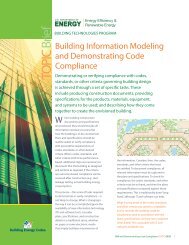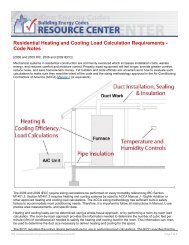Alabama - Building Energy Codes
Alabama - Building Energy Codes
Alabama - Building Energy Codes
Create successful ePaper yourself
Turn your PDF publications into a flip-book with our unique Google optimized e-Paper software.
Technical Appendix A<br />
Methodology<br />
An overview of the methodology used to calculate these impacts is provided below. Further information as to<br />
how these estimates were developed is available at the U.S. Department of <strong>Energy</strong>’s (DOE) <strong>Building</strong> <strong>Energy</strong><br />
<strong>Codes</strong> website. 1<br />
Cost-Effectiveness<br />
Pacific Northwest National Laboratory (PNNL) calculated three cost-effectiveness metrics in comparing the 2009<br />
and 2012 International <strong>Energy</strong> Conservation <strong>Codes</strong> (IECC) to the 2006 IECC. These are:<br />
• Life-Cycle Cost (LCC): Full accounting over a 30-year period of the cost savings, considering energy<br />
savings, the initial investment financed through increased mortgage costs, tax impacts, and residual<br />
values of energy efficiency measures<br />
• Cash Flow: Net annual cost outlay (i.e., difference between annual energy cost savings and increased<br />
annual costs for mortgage payments, etc.)<br />
• Simple Payback: Number of years required for energy cost savings to exceed the incremental first costs<br />
of a new code<br />
LCC is a robust cost-benefit metric that sums the costs and benefits of a code change over a specified time<br />
period. LCC is a well-known approach to assessing cost-effectiveness. DOE uses LCC for determining the costeffectiveness<br />
of code change proposals, and for the code as a whole, because it is the most straightforward<br />
approach to achieving the desired balance of short- and long-term perspectives.<br />
The financial and economic parameters used for these calculations are as follows:<br />
• New home mortgage parameters:<br />
o 5.0% mortgage interest rate (fixed rate)<br />
o Loan fees equal to 0.7% of the mortgage amount<br />
o 30-year loan term<br />
o 10% down payment<br />
• Other rates and economic parameters:<br />
o 5% nominal discount rate (equal to mortgage rate)<br />
o 1.6% inflation rate<br />
o 25% marginal federal income tax and 5% marginal state income tax<br />
o 0.9% property tax<br />
o Insulation has 60-year life with linear depreciation resulting in a 50% residual value at the end of<br />
the 30-year period<br />
o Windows, duct sealing, and envelope sealing have a 30-year life and hence no residual value at<br />
the end of the analysis period<br />
o Light bulbs have a 6-year life and are replaced four times during the 30-year analysis period<br />
<strong>Energy</strong> and Economic Analysis<br />
This analysis determined the energy savings and economic impacts of the 2009 and 2012 IECC compared to the<br />
2006 IECC. <strong>Energy</strong> usage was modeled using DOE’s <strong>Energy</strong>Plus software for two building types:<br />
1 www.energycodes.gov/development/residential<br />
A.1 April 2012
















